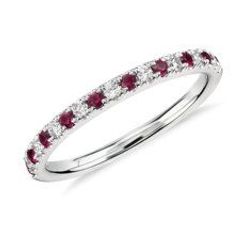What is a ruby?
Rubies, like sapphires, are derived from the mineral corundum, but whereas sapphires can be any color, rubies are always a shade of red—from the striking, saturated red we most commonly associate with these gemstones to softer shades of pink. Because of their striking color and relative rarity, rubies are some of the highest-priced colored gemstones. Rubies are the traditional birthstone for July.

Mineral: Corundum
Origins: Myanmar, Thailand, India,
Pakistan, Nepal
Symbols: Wealth, Passion, Inspiration
Properties: Protection
Durability: 9
ENHANCEMENTS
Heated and/or infused to improve color and clarity
CARE
Basic Gemstone Care
SIMILAR GEMSTONES
Rob Lavinsky, iRocks.com – CC-BY-SA-3.0, CC BY-SA 3.0,
via
Wikimedia Commons / Cropped from original

What to Look for in Ruby Gemstones
Rubies are desirable in any form, whether as a special occasion piece or for everyday wear. Ultimately, you should choose a ruby that makes your heart beat a little faster, whether it meets the standards of the “most desirable” or simply because it captures your eye. We believe that the true value of a gemstone lies in its effect on the wearer.
COLOR
Gemstone color is typically the most important aspect of a gemstone. Rubies with a saturation of pure red are less common than other rubies, and they’re more expensive. Rubies that are less red and more pink are more affordable—and just as luscious as deep-red varieties. Rubies in all shades of red may exhibit a secondary tone, including orange, pink and purple, but all other colors of the mineral corundum are classified as sapphires.

CUT
A gemstone’s cut should highlight its best aspects and provide symmetry and balance. Our rubies are cut to showcase their distinctive combination of color, clarity and brilliance. To maximize reflection, rubies may have a more shallow cut to allow in more light and sparkle, or they may be cut more deeply to showcase a dark color saturation.

CLARITY
Gemstone clarity refers to how “eye-clean” a gemstone is. Most natural gemstones contain inclusions, which are materials like gas bubbles, minerals or liquid that are trapped within the stone while it forms. The fewer visible inclusions in a ruby, the more valuable it is. A typical ruby includes needles, an inclusion characterized by intersecting patterns called silk.

SIZE (CARAT)
Rubies are denser than diamonds, so what we consider a carat weight for a ruby differs from that of a diamond. That’s why the size of gemstones, including rubies, is measured by their diameter in millimeters. A ruby measuring six millimeters in diameter is roughly equivalent to one carat. Rubies over one carat are very rare.

ENHANCEMENT
Most gemstones on the market today, including rubies, are enhanced with heat treatments or infusions to help improve the color and clarity. Our rubies undergo rigorous internal inspections and are of the highest quality.

HARDNESS & WEARABILITY
Rubies are very durable, earning a 9 out of 10 on the Mohs scale of hardness. A diamond, the hardest of all gemstones at a rating of 10, is the only natural thing that can scratch a ruby. This makes ruby jewelry suitable for everyday wear, whether in a beautiful ring setting, a bold pendant necklace or sparkling earrings.

Choosing the Right Ruby Jewelry
Ultimately, selecting a piece of ruby jewelry should come down to what you adore. Red hues are often associated with luck, romance and courage. Rubies, also known as the “protection” stone, are said to imbue the wearer with happiness, passion and vitality, making these gemstones a great symbolic piece for your collection—or a meaningful gift while oval peridot bracelets have more of an elegant appeal. for someone special.
Shop Popular Ruby Jewelry
Famous Ruby Gemstones
Rubies have long been coveted by collectors and consumers all over the world. At an impressive 23.1 carats, the Carmen Lúcia Ruby was a gift from her husband, Peter Buck, and is currently on display at the Smithsonian. The world's largest mined ruby, the Liberty Bell Ruby, weighs four pounds and is sculpted into a miniature form of the Liberty Bell and embedded with 50 diamonds. It was stolen in 2011 and has yet to be recovered.
LEARN MORE ABOUT GEMSTONES
Rubies are just one of the many stunning gemstones you’ll find in our selection. Learn about other gemstones, and find a new favorite today.



















